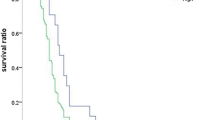Abstract
Purpose
The plasma D-dimer (D-dimer) level, a marker of hypercoagulation, has been reported to be associated with survival in several types of cancers. This retrospective study was conducted to evaluate the prognostic significance of the preoperative D-dimer level in patients with completely resected non-small cell lung cancer (NSCLC).
Methods
A total of 237 completely resected NSCLC patients were included in this study. In addition to age, sex, the smoking status, etc., the association between the preoperative D-dimer level and survival was explored.
Results
The patients were divided into three groups according to the D-dimer level: group A (≤0.50 μg/ml, n = 76), group B (0.51–0.86 μg/ml, n = 79) and group C (>0.86 μg/ml, n = 82). The 5-year overall survival rate was 89.6 % (95 % confidence interval (CI) 77.7–95.3) for group A, 75.1 % (95 % CI 62.3–83.6) for group B and 60.1 % (95 % CI 46.8–71.1) for group C (P trend <0.001). A multivariate survival analysis showed that the D-dimer level (group B vs. group A HR 4.25, group C vs. group A HR 4.11) was an independent significant prognostic factor, in addition to age, sex, the pathological stage and the serum carcinoembryonic antigen level.
Conclusions
The preoperative D-dimer level is an independent prognostic factor in patients with completely resected NSCLC.


Similar content being viewed by others
References
Trousseau A. Plegmasia alba dolens. Lectures on clinical medicine, delivered at the Hotel-Dieu, Paris. 1865; 5: 281–332.
Sack GH, Levin J, Bell WR. Trousseau’s syndrome and other manifestations of chronic disseminated coagulopathy in patients with neoplasms: clinical, pathophysiologic, and therapeutic features. Medicine. 1977;56:1–37.
Varki A. Trousseau’s syndrome: multiple definitions and multiple mechanisms. Blood. 2007;110:1723–9.
Pabinger I, Ay C. Biomarkers and venous thromboembolism. Arterioscler Thromb Vasc Biol. 2009;29:332–6.
Blackwell K, Haroon Z, Broadwater G, Berry D, Harris L, Iglehart D, et al. Plasma D-dimer levels in operable breast cancer patients correlate with clinical stage and axillary lymph node status. J Clin Oncol. 2000;18:600–8.
Batschauer AP, Figueiredo CP, Bueno EC, Ribeiro MA, Dusse LM, Fernandes AP, et al. D-dimer as a possible prognostic marker of operable hormone receptor-negative breast cancer. Ann Oncol. 2010;21:1267–72.
Blackwell K, Hurwitz H, Liebérman G, Novotny W, Snyder S, Dewhirst M, et al. Circulating D-dimer levels are better predictors of overall survival and disease progression than carcinoembryonic antigen levels in patients with metastatic colorectal carcinoma. Cancer. 2004;101:77–82.
Morii T, Mochizuki K, Tajima T, Ichimura S, Satomi K. D-dimer levels as a prognostic factor for determining oncological outcomes in musculoskeletal sarcoma. BMC Musculoskelet Disord. 2011;12:250–5.
Sawabata N, Miyaoka E, Asamura H, Nakanishi Y, Eguchi K, Mori Y, et al. Japanese Lung Cancer Registry Study of 11,663 surgical cases in 2004: demographic and prognosis changes over decade. J Thorac Oncol. 2011;6:1229–35.
Endoh H, Yamamoto R, Satoh Y, Kuwano H, Nishizawa N. Risk analysis of pulmonary resection for elderly patients with lung cancer. Surg Today. 2013;43:514–20.
Matsuguma H, Nakahara R, Igarashi S, Ishikawa Y, Suzuki H, Miyazawa N, et al. Pathologic stage I non-small cell lung cancer with high levels of preoperative serum carcinoembryonic antigen: clinicopathologic characteristics and prognosis. J Thorac Cardiovasc Surg. 2008;135:44–9.
Lim E, Clough R, Goldstraw P, Edmonds L, Aokage K, Yoshida J, et al. Impact of positive pleural lavage cytology on survival in patients having lung resection for non-small-cell lung cancer: an international individual patient data meta-analysis. J Thorac Cardiovasc Surg. 2010;139:1441–6.
Shiono S, Abiko M, Sato T. Positron emission tomography/computed tomography and lymphovascular invasion predict recurrence in stage I lung cancers. J Thorac Oncol. 2011;6:43–7.
Ay C, Dunkler D, Pirker R, Thalar J, Quehenberger P, Wagner O, et al. High D-dimer levels are associated with poor prognosis in cancer patients. Haematologica. 2012;97:1158–64.
Taguchi O, Gabazza EC, Yasui H, Kobayashi T, Yoshida M, Kobayashi H. Prognostic significance of plasma D-dimer levels in patients with lung cancer. Thorax. 1997;52:563–5.
Altiay G, Ciftci A, Dermir M, Kocak Z, Sut N, Tabakoglu E, et al. High plasma D-dimer level is associated with decreased survival in patients with lung cancer. Clin Oncol. 2007;19:494–8.
Zhang PP, Sun JW, Wang XY, Liu XM, Li K. Preoperative plasma D-dimer levels predict survival in patients with operable non-small cell lung cancer independently of venous thromboembolism. Eur J Surg Oncol. 2013;39:951–6.
Tanaka F, Yoneda K, Kondo N, Hashimoto M, Takuwa T, Matsumoto S, et al. Circulating tumor cell as a diagnostic marker in primary lung cancer. Clin Cancer Res. 2009;15:6980–6.
Acknowledgments
We are grateful to Dr. Keitaro Matsuo, Department of Preventive Medicine, Kyushu University Faculty of Medical Science, for his advice and review of the statistical analysis.
Funding
This study was supported in part by a grant from takeda Science Foundation.
Conflicts of interest
None of the authors has any conflict of interest to declare in association with this study.
Author information
Authors and Affiliations
Corresponding author
Rights and permissions
About this article
Cite this article
Fukumoto, K., Taniguchi, T., Usami, N. et al. The preoperative plasma D-dimer level is an independent prognostic factor in patients with completely resected non-small cell lung cancer. Surg Today 45, 63–67 (2015). https://doi.org/10.1007/s00595-014-0894-4
Received:
Accepted:
Published:
Issue Date:
DOI: https://doi.org/10.1007/s00595-014-0894-4




